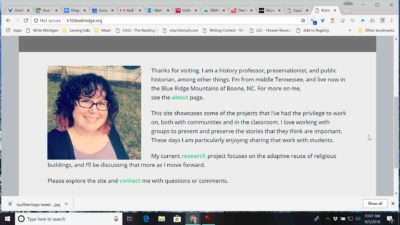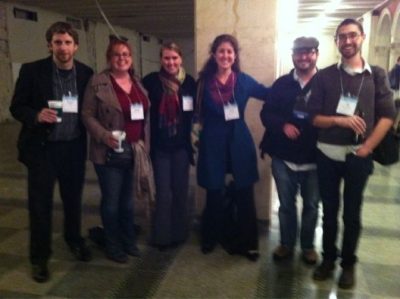Teaching the digital self
13 September 2018 – Kristen Baldwin Deathridge
NCPH Board Member Posts, digital media, methods, digital history, media, entrepreneurialism, education, training

Screenshot from Kristen Baldwin Deathridge’s WordPress-based professional website, k10deathridge.org.
“Don’t include images because they slow everything down too much.” “Use tables and frames to organize your website.” “Visual interface is more important than content.” “Flash will save the internet.” “No one wants to read or watch videos on their tiny little phone.” “Use the brightest colors possible.” All of these statements had their axiomatic moment, but with the advantage of technological hindsight, these ideas seem archaic, though they are thirty years old at most. From basic html through to mobile optimization, the ways that people present themselves to the online world have shifted.
I came into the public history profession at a time when digital history was becoming more and more relevant, but was only just being incorporated formally into many graduate programs (I completed my PhD in 2012). As a result, I had to do a lot of my own research on entry level things like professional websites. I began following debates in digital history and humanities on Twitter, reading articles on digital pedagogy, and attending sessions on digital work at conferences. Once I got a tenure-track job, I began teaching digital history to graduate and undergraduate students. Reflection is an important part of being a public historian, and as I did these things and completed the NEH Doing Digital History institute in 2016, I’ve been reflecting on how I developed my own digital presence and how I teach students. In 2014, I incorporated some of that reflection into the structure of an assignment created for the first digital history course I taught.
Over the semesters that I’ve used this assignment, the instructions have shifted, but the core goal remains the same. I want folks to think intentionally about their digital presence and to write self-reflectively about their choices. For class, students create a professional website and write an essay about that site and their digital media strategy. The most recent version of the assignment is here (pdf). In preparation, we do an in-class workshop and I help the students to sign up for hosting and to install WordPress.org. I assign readings on creating academic websites, how to use Twitter, and how cultural organizations use social media. We spend several class meetings discussing the values of various social media platforms, web design, and identity and privilege in online presentation. I also explain my own digital presence and choices.
My graduate programs did not offer any specific courses in digital history, and I cannot imagine what course I would trade to have taken one. At the time, the PhD program required students to create a professional portfolio as a part of our public history qualification process. This could be an analog version—those who chose that path often submitted 5-inch binders full of paper—or a digital one. I chose digital. This meant figuring out on my own so many things mentioned in this piece by Roger Whitson. Angela Smith (NDSU) completed hers before me and was generous enough to sit with me over dinner and explain the process.
As I began work on my professional website, there were several questions I needed to answer. I decided on a WordPress.com hosted site because I wasn’t ready to commit to the expense of paid hosting (This was pre-Reclaim Hosting). Our free options were limited to WordPress, Blogger, or Google sites; there were no plug and play portfolio/resume sites. I chose the WordPress system because it was flexible, and I knew that I could go in and mess with the html a bit, provided I could find the right online tutorial. I spent a long time learning how to customize templates. I also needed to decide which other sites I should link to my portfolio and wondered what would help me on the job market. Throughout the process there was little guidance, and I struggled with what still felt to me like emerging technologies.

From the #builtheritage tweet-up in Buffalo, NY, October 2011, when most people’s camera phones were more of a dream than a reality. Photo credit: Kristen Deathridge
I wrangled with deciding whether or not to connect my Twitter account to my professional website. I joined Twitter in 2010, before I even owned a smartphone, to participate in contests at San Diego Comic-Con. I texted in my tweets and couldn’t read anything other than direct responses until I got to a computer, sometimes days later. But by the time I was building my website, I had found a thriving professional network on Twitter. My entry point was the now-defunct #builtheritage chat run by folks at the National Trust. My Twitter usage expanded from there as I got into chatting about higher-ed with folks in the digital humanities and who were studying mental health in the academy. Regardless of the specific platform, the main question is: Should a person link the rest of their life to what we want to present as the professional one? And, if the answer is yes, how?
When I give students the assignment to create their own personal digital strategy and websites, I share in depth about my own shifting social media and web strategy (I’m on at least the third iteration of my portfolio site). I try to emphasize that there aren’t right or wrong ways to shape one’s digital presence; there’s only whether or not someone thinks through their decisions. We discuss all of this as an aspect of being self-reflective public historians, a concept that I learned from many but which owes the most to Rebecca Conard and the edition of The Public Historian that she edited. Some of the questions that I asked myself when I designed my first professional website continue to be relevant for today’s students: What tools should be used? Do we link our “personal” and “professional” digital lives? Is such separation realistic? How far does each of us want to dig in to the world of digital history?
To go deeper: How does one practice being a self-reflective public historian online? What are the limits of public scholarship these days if one does not maintain any online presence? What is the relationship between social media and digital scholarship? I’d argue that these questions are relevant for all of us, not just students. I continue to shape and reshape my own answers to these questions; please share yours in the comments.
~ Kristen Baldwin Deathridge earned a PhD in Public History from Middle Tennessee State University in 2012 and is an assistant professor at Appalachian State University. She serves on the NCPH Board of Directors. You can find Kristen on Twitter @k10death.




interesting story, I just like your post.